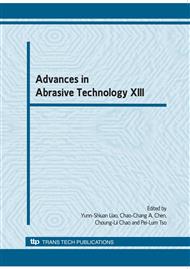p.295
p.305
p.311
p.316
p.320
p.326
p.332
p.341
p.347
Friction Phenomenon in Chemical Mechanical Polishing of Oxide Film
Abstract:
The friction phenomenon was investigated to explore the relationship between the diamond conditioner, polishing pad and wafer of oxide film in the chemical mechanical polishing (CMP) process. Two kinds of diamond conditioners (disk-A and disk-B) were used. Diamond disk-A used was traditional diamond conditioner containing random shaped diamond grits. Diamond disk-B used was made by sculpturing a sintered polycrystalline diamond to form identically shaped cutting tips. Experimental results reveal that friction force between disk and pad increases with dressing load. But friction force decreases with sliding speed due to increase of sliding speeds resulting in an increase of interface temperature. The coefficient of friction between wafer and pad initially increases with the dressing load, and then it starts to drop slowly with further increases of the dressing load. It was found that removal rate of the oxide film correlates well with the variation of the coefficient of force. In addition disk-B can produce a higher wafer removal rate under a low dressing load.
Info:
Periodical:
Pages:
320-325
Citation:
Online since:
August 2010
Authors:
Price:
Сopyright:
© 2010 Trans Tech Publications Ltd. All Rights Reserved
Share:
Citation:


